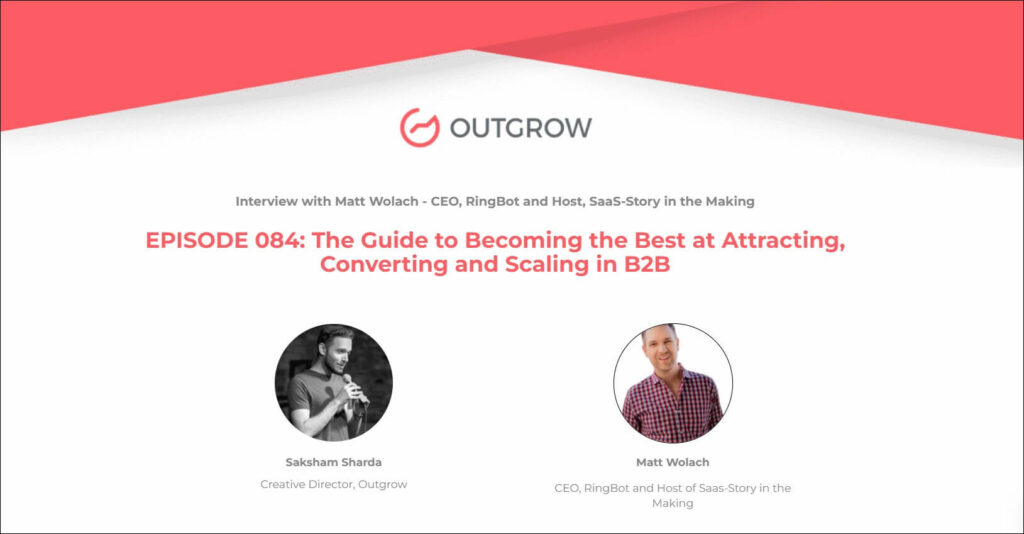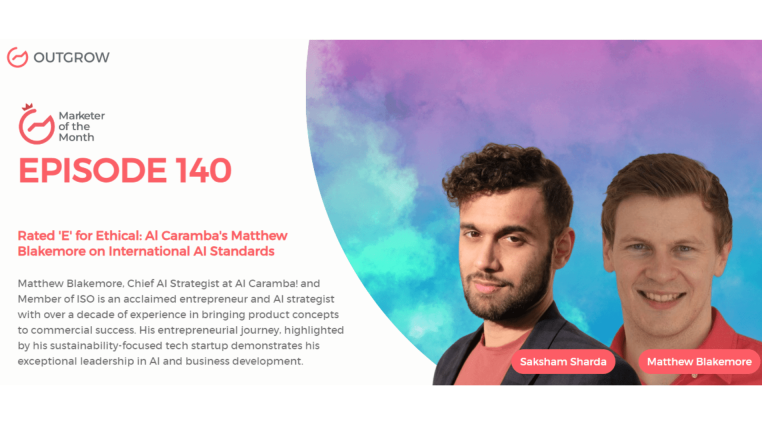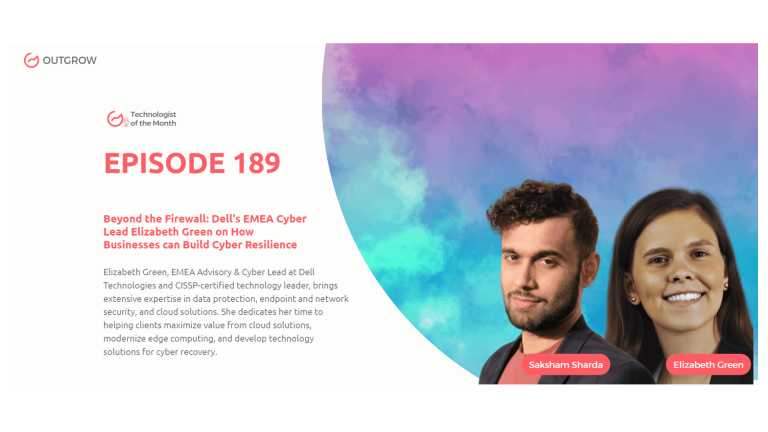Marketer of The Month Podcast- EPISODE 084: The Guide to Becoming the Best at Attracting, Converting and Scaling in B2B
Table of Contents
Hey there! Welcome to the Marketer Of The Month blog!
We recently interviewed Matt Wolach for our monthly podcast – ‘Marketer of the Month’! We had some amazing insightful conversations with Matt and here’s what we discussed about –
1. Reasons why software companies struggle to scale beyond the initial team
2. Most crucial parts of the sales process
3. Changing the way sales is perceived
4. Biggest mistakes companies make when trying to win more deals
5. Metrics growing tech companies should target
6. How to differentiate from your competition
About our host:
Dr. Saksham Sharda is the Chief Information Officer at Outgrow.co. He specializes in data collection, analysis, filtering, and transfer by the means of widgets and applets. Interactive, cultural, and trending widgets designed by him have been featured on TrendHunter, Alibaba, ProductHunt, New York Marketing Association, FactoryBerlin, Digimarcon Silicon Valley, and at The European Affiliate Summit.
About our guest:
Entrepreneur, investor, coach, and leader Matt Wolach is the host of SaaS-Story in the Making and has a wealth of experience in the sales sector. Matt has almost two decades of experience in SaaS sales management and is a pro at streamlining the buyer journey to maximize conversions at every stage, from lead to close.
EPISODE 084: The Guide to Becoming the Best at Attracting, Converting and Scaling in B2B
The Intro!
Saksham Sharda: Hi, everyone. Welcome to another episode of Outgrow’s Marketer of the Month. I’m your host, Dr. Saksham Sharda. I’m the creative director at Outgrow.co And for this month we’re going to interview Matt Wolach, who is the founder and CEO of RingBot and the host of the SaaS-Story in the Making Podcast. Thanks for joining us, Matt.
Matt Wolach: Absolutely. Thanks, Saksham, I’m excited to be here.
Don’t have time to read? No problem, just listen to it on Spotify!
The Rapid Fire Round!
Saksham Sharda: So Matt, we’re going to start with a rapid-fire round just to break the ice. You get three passes. In case you don’t want to answer the question, you can just say pass. But try to keep your answers to one word or one sentence only. Okay?
Matt Wolach: Okay, perfect. I’m excited.
Saksham Sharda: At what age do you want to retire?
Matt Wolach: 55
Saksham Sharda: How long does it take you to get ready in the mornings?
Matt Wolach: 30 minutes.
Saksham Sharda: The most embarrassing moment of your life?
Matt Wolach: When my trumpet broke during a middle school solo performance.
Saksham Sharda: Okay, favorite color?
Matt Wolach: Purple.
Saksham Sharda: What time of day are you most inspired?
Matt Wolach: 9 am
Saksham Sharda: How many hours of sleep can you survive on?
Matt Wolach: Five.
Saksham Sharda: Fill in the blank: An upcoming sales trend is ________.
Matt Wolach: Texting
Saksham Sharda: The city in which the best kiss of your life happened?
Matt Wolach: Phoenix.
Saksham Sharda: Pick one – Mark Zuckerberg or Jack Dorsey?
Saksham Sharda: *Guessing*
Saksham Sharda: That is a timeout. The biggest mistake of your career?
Matt Wolach: Not becoming a founder earlier.
Saksham Sharda: How do you relax?
Matt Wolach: Reading and playing games.
Saksham Sharda: How many cups of coffee do you drink per day?
Matt Wolach: Zero.
Saksham Sharda: A habit of yours that you hate?
Matt Wolach: Eating way too many sweets.
Saksham Sharda: The most valuable skill you’ve learned in life?
Matt Wolach: Being able to create enthusiasm.
Saksham Sharda: And the last one is your favorite Netflix show?
Matt Wolach: Ozark
Saksham Sharda: Okay, so you answered most of the questions except one that you passed. So you score 9/10 and you win a car. Just kidding. You don’t win it.
The Big Questions!
Saksham Sharda: Yeah, so the long-form questions which you can take as much time as you’d like to answer. The first one is why do software companies struggle to scale beyond the initial team you think?
Matt Wolach: Yeah, I think that’s a very common one, I work with a lot of software companies as a coach, and I help them kind of grow and scale their company. And a lot of times, it’s the early stage founders who have finally gotten the ball rolling, they’re starting to see some traction, they’re starting to make some things happen for their company, but then they need to turn it over to a sales team, they need to have other people take over and kind of run the show and scale. And a lot of companies kind of fall flat at that point. And they’re not able to get it from the early stage founders and leaders to the next generation, so to speak of, salespeople and sales leaders taking over and running. And what I’ve found through working with hundreds of different companies in my coaching business is that a lot of times, it’s because they never set up a process. What happens is the founders can accomplish some of the early growth, because they have so much sheer desire to see the company make it, they care so much that they put sheer force and will into it. And it starts to make things happen. But because they have so much passion, doesn’t necessarily mean the next person will have that passion. Nobody else you hire will have as much passion as you if you’re the founder. So founders don’t see that or get it. They think that if they bring somebody else in and they have a sales background, then they’re going to succeed. It’s not necessarily the case. And so it’s really important for founders to not rely on just their sheer passion that made it happen early, but actually to have a process and have a formula for people to follow. And, I went through this same learning of this phenomenon myself when I tried to hand it over to somebody. They came in and they couldn’t do anything. They had a great sales background, and the great experience they came in and could not sell a thing. And I learned that I had to have a process for them to follow. And when I hired two other people who did have the same background as the first guy they came in. Because we had a formula at that moment, they were able to follow that process and achieve incredible success. So make sure you have a sales process when you do, it’ll make it much easier to be able to hand off everything for the sales side. So you can continue to grow and scale even further.
Saksham Sharda: So this leads to two sub-questions. So the first one is, what does the founder do if he does manage to make a working process? So what is he supposed to be looking at after that? Say you make a system and it’s working and it seems like everything is going well. What does the founder do, then?
Matt Wolach: Yeah, at that point, if you’ve proven that process works, now you need to bring people in and start training them. To find the right people, find people who match the culture in the organization, find people who are motivated, and enthusiastic, bring them in, train them on the process, and make sure they fully believe and understand the process. And then once you see that, they’re able to do it, then great. And by the way, for me, when I hire people, especially within the sales world, I’m a big believer that we should be hiring multiple people, hire two or three people. Because if you bring one person in, and you train them, and you give them up speed, they go out there, and then nothing happens. Well, you don’t know is it the process? Is it what we’re doing right now? Is it the formula? Or is it the person and you’re not sure? But if you have two people, and one of them does great, and one of them doesn’t do so great, then you know, it’s the person. If both don’t do great, then you know something’s wrong with the process. So we want to figure out how where it’s coming from, and where the problems are. And that comes from hiring multiple people. Now, I know early-stage companies, but that’s not always possible. But as much as you can make that happen, it’s really important to do so.
Saksham Sharda: And so the second thing that I wanted to ask related to this question was, so this is something that we’re seeing, from my personal experience is that a lot of the founders of big tech companies are similarly taking a backseat and letting CEOs do the job, like CEOs that they’ve hired. So is that the model everyone should be following? Like Jack Dorsey and Mark Zuckerberg, the question you couldn’t answer is that Mark Zuckerberg continues to be involved while Jack Dorsey has taken a backseat, and so on.
Matt Wolach: I lean towards taking the back seat. So a lot of early-stage founders are like they start the company, they get it off the ground, they get that early traction, they dig their heels in, make it happen. And then they get it to a million, and then 8 to 10 million. And maybe beyond that, well, that personality type, that early stage, a startup founder, you know, capability and the culture that they have, doesn’t always line up with the person that needs to take it from 10 million, or from 100 million to a billion. Those are different skill sets. And you have a completely different role. For example, the founder, in the beginning, is doing everything, and learning all sorts of different pieces of the business and implementing this and doing that and getting their hands dirty, right in the thick of it. But as you become a bigger and bigger company, it’s other people doing it. And the CEO technically doesn’t do, “any of the work”. They’re overseeing the people and supporting the people doing the work. And so the role changes. And it’s a very rare person who would be able to be that early-stage startup founder, and also be able to be a $100 million company, CEO. And so it’s typically I believe a smart thing to be able to turn it over and hand it off to somebody else who can do it. And of course, many people stay on the board, they as chairman of the board, and they kind of oversee that CEO, but somebody else who understands how to get the company from this point, now that we’ve reached it to the next threshold, I think can be a really powerful way for a company to scale.
Saksham Sharda: So what would you say would be the most important parts of the sales process at the beginning of a company? And then once they crossed the threshold, how do these parts change?
Matt Wolach: Yeah, I mean, the great question there. So first of all, the most important part of the sales process is being able to understand your market, knowing who you’re serving, if you don’t know and I just was talking with a client yesterday on this and he still is not sure who he’s supposed to be serving. He’s kind of like, it’s all things for all people. Well, the problem with that is if you don’t know exactly who that person is that you’re selling to, you can’t develop your product towards them and what they need. You can’t align your marketing messaging with their lingo and what they talk about in that industry. And you can’t align your sales process with the way that their workflow is. So you’re gonna have a tough time getting people to buy and getting people even interested if you don’t know your ICP, your ideal customer profile. And so that’s critical right at the beginning, once you have that, now we can start to set our marketing campaigns or marketing plans to align with what they’re doing to get in, you know, within their language and what they talk about, to talk about the goals that they’re trying to achieve, the challenges. And that buyer journey should be consistent through marketing through sales, onboarding, customer success, all of that you should be speaking the same language. And we should have a very consistent message to the buyers so that they feel comfortable, they feel like you are their guides, you are their warm blanket, helping them through troubling times and getting them to the solutions that they need. And when you can do that, those are the companies that usually thrive and succeed that know their market well enough know how to get them the products and the solutions that they need extremely well, and can deliver on what they say. So that’s something that I’ve learned, sometimes the hard way, and it’s something that I teach.
Saksham Sharda: Okay, and so many people, in general, have an image of sales that is a bit sketchy. So why and how can sales leaders change this perception?
Matt Wolach: Yeah, this is pretty natural, if you’re buying something, you have the salesperson call you, we kind of put a wall up, we kind of have our wall up, I don’t want to be sold, I don’t want them to pull any tricks on me and try and get me to buy this or that. And, you know, we’re all kind of worried about that. And there is kind of a perception that’s been built over time of sketchy salespeople and sketchy tactics that are used to try and get people to do things that they don’t want to do. First of all, I think that does justify some of those perceptions because of some of the things that have happened in the past, but I think we need to change that perception. And I firmly believe that salespeople should be thinking of themselves more as helper people. And when you start to align with that type of methodology, and that thinking of I want to help these people instead of I need to close them, I need to meet my numbers, I need to sell them. Your entire aura kind of changes and you start to realize, hey, what can I help them understand? What can I educate them on? What can I help them overcome? How can I get them to where they need to be? How can I help them through these challenging times? And when you start to think in those ways, just the entire way you come off, you don’t look so skeevy and sketchy, you don’t look so weird, you come off sounding like “hey, I’m here to help, I want to make sure that things are working.” And people receive it so much better, that wall I talked about comes down. And they’re much more open to receiving help, as opposed to being sold. And so if you’re there to help, if you’re there to guide and get them through the troubling times the right way, then people love you. And a lot of my clients, when they’ve made this change, they’ve gone from pushing sales to, “Hey, I just want to help, I want to achieve helping people get to a certain level”, they see their sales go up. So it’s kind of funny that you’re not focusing on sales, but you’re selling more. And it’s pretty phenomenal that this can happen. But it’s cool when it does.
Saksham Sharda: And on the flip side, then what are some of the biggest mistakes companies make when trying to win more deals?
Matt Wolach: Not enough companies are implementing the right sales process. And so what they’re doing is they’re thinking, if we just hire salespeople, then we can just throw them all in and hope that some of them make it and start selling, but they don’t have the process in place to be able to do that, they don’t have a team aligned. And I’ve always thought also that a sales team needs to have that team and ship and you have to be able to have teamwork amongst the members and be able to, you know, have that camaraderie. Yes, of course, sales teams are going to be competitive, you want to be the number one and that’s kind of a good thing. But you also want to make sure that the sales team is sharing experiences “Hey, I just saw this, have you guys seen. Hey, I noticed this” or what about that, you have the teammates helping each other at all level up. And if everybody can get better than the company is going to be the best for it, they’re going to thrive. And so I think too many companies are not implementing the right sales process. And they’re not getting the sales team to work together to make that process better and better. A sales process should be a living, breathing thing. It’s not just going to be some rigid thing. If you notice one thing that’s going to make it better, if you notice something that’s going to improve it or something that’s not helping, adjust and mold and get yourself to the right situation continually iterate, to get better and better on your process. The companies doing that are the ones who are thriving and making things happen.
Saksham Sharda: So in addition to establishing a process and a good team, which growth metrics should growing tech companies be targeting, you think?
Matt Wolach: Good question. So, first of all, one thing I love in terms of a growth metric is your lead-to-first call rate. And it’s something that’s kind of an earlier stage metric. But a lot of people are working hard driving leads, and they’ve got these great marketing campaigns happening. But they’re not doing a good job of the next stage, the leads come, but they’re not capturing those leads. And so there’s a big difference between lead generation and lead capturing. And so they’re not capturing those leads, they are not getting them to that next stage. And so that is a big one that most companies are not tracking. And you might be surprised to learn that the companies who don’t track that what I call lead to demo ratio, or lead the first call ratio, they’re averaging 45%, meaning less than half of the companies who say I want to talk to somebody ever end up on a call. Of course, we all know that we’ve had leads come in, and we’ve reached out to them, and they ghost us and nobody ever responds, you don’t know why, we’ve had the time when somebody books a call, and then they never show up to the call. And you’re wondering why as you’re just sitting there with your zoom open? Well, all of that happens eventually 45% is the end-up measurement. But the companies who do track this number, the companies who actively track it and realize we need to put processes in place to improve that number, see an average of about 70 to 80%. And so you can almost double the number just by tracking it and putting in the right processes. Imagine going from 45% of the leads that come in to book to 80% of the leads that come in actually book just right there without fixing anything else, you’re going to lose a lot more deals, you’re gonna have a lot more sales conversations, you’re gonna be making a lot more revenue. So that’s number one is your lead to first call rate, absolutely track it and start putting in processes to make it better. The second one would be your CAC, payback period. CAC is your customer acquisition cost. What it is, is it’s how much is it costing you for each customer that you acquire, you take all of your sales and marketing expenses, that includes all the people on the sales and marketing teams, all the stuff you’re paying for in terms of tools, all of the ads spend all of it, you add it all up. And then you say how many customers did we win based on that. And so if you spent $10,000, and you won 10 customers, you spent $1,000 per customer. So it’s $1,000 as your CAC, your customer acquisition cost, it’s a really important metric. But you also want to look at the CAC payback period. And especially if you’re going to get funding, if you’re going out for investment, or you want to sell your company, this is something that the investors are going to want to know that CAC payback period refers to, okay, we spent the money, we spent that $1,000 to acquire a single customer, how long until they pay us enough that we get that money back. And so if they’re paying you $100 a month, well to get 1000, it takes 10 months, 10 months of them paying you until they’ve paid for the amount of money you spent to get them. Now the baseline metric is or the benchmark I should say 12 months, if your CAC payback period is less than 12 months, you’re in good shape. And if you want to scale nine, six to nine months, somewhere in there would be something to aim for. But if it’s less than 12 months, you’re in good healthy financial shape, meaning, okay, we can get paid back eventually within a year for what we spent to acquire a customer. If it’s over 12 months, you’re in trouble. For 13-15, I’ve seen 20, I saw a 28-month CAC payback if you can believe it’s actually, it’s really bad because it’s taking you two to three years to make enough money for what you spent to get that customer that is not a healthy financial situation, and something’s going to hamper the company in its growth. So your CAC payback makes it less than 12 months. The third one would be your LTV to CAC, that’s your lifetime value as a ratio to the CAC that we just talked about. So basically lifetime value is how much is your typical customer going to pay you for their entire life of being with you. Now part of this is based on your churn rate, you have to know how quickly people are going to leave. And what it does is it calculates how much they’re paying you every month on average.
Matt Wolach: Take your turn right into the calculation, you get a lifetime value. So if they’re paying you 100 bucks a month, you might have a lifetime value of $2000 to $3,000 or something based on how many months they pay you over time. Well that lifetime value, you throw that as a ratio versus the CAC. If your CAC is 1000 and your lifetime value is 3000. That’s a 3:1 ratio. Now looking at this number and what the benchmarks are, the LTV to CAC, one-to-one is not good. That means you spend 1000 They’ll only pay Do 1000 for their entire life, you didn’t make any money. That’s not a business. And especially since the CAC is only counting, sales, and marketing expense, not any of the other expenses, so you’ll lose money, if you’re only making as much as they’re giving you. The ideal situation is between three and five, do you think about it three to one LTV to CAC, that means I spend 1000, I get 3000, I get for every dollar I give, I’m getting three back four, five, somewhere in there as a great ratio, I spend $1, I get five back, that’s a great business, you know that’s something you can scale. Because you say, “Hey, we’re spending $1, we get five. If you give me $1, I’m gonna give you five, how many dollars you want to give me, a lot.” Every time I get five more. Now, some people say, “Well, Matt, that’s awesome. We’re gonna try and get it to 6-7-10-15 to one”, and just had a client, I was talking to a couple of days where they’re a 12 to one. But it’s a little bit upside down at that point. And it’s it is great. In the short term, of course, you’re making 12 bucks for every $1 that somebody spends on this. That’s great. But the problem is, you’re not scaling enough now. Because if it’s that high, you’re not spending enough, put more money into marketing, get more tools, get more capabilities, get more ads out there, getting your presence out there, build your brand, do whatever you can, because it’s working, you’re spending money, and you’re getting it back. So start spending more, and you’re gonna start scaling well. And so those would be the ones that I would make sure I’m targeting as an early-stage company if I want to grow.
Saksham Sharda: And how would all this be different when it comes to targeting enterprise deals versus small and medium business deals?
Matt Wolach: Yeah, great question. Enterprise deals, one of the big things, they’re going to take a lot longer typically as the sales cycle is going to be much deeper, much more involved, and quite a bit longer. Small-medium deals can be very transactional, and you can burn in turn, as I say, and get a lot of deals quickly. A lot of the ratios should still be about the same, though, because that large deal should be paying you quite a lot. Yeah, you’re probably going to spend more on it in terms of your CAC. But you should be getting quite a bit more, the key thing is just to make sure that the ratios are balancing. So we all know that to get a tiny little $97 a month deal, well, you’re gonna probably spend less, but you should be able to get a lot of those deals for the amount you spend. But you’ll need to get a lot of them, the volume needs to be there. But to get a $ 150,000-a-year deal, you might have to spend $5,000-$10,000 to do it, but it’s going to pay off, you’re going to get a huge deal that usually big deals stick around a lot longer, in turn, rates lower. So the LTV, the lifetime value is typically higher. So the ratios are very similar. But the numbers within those ratios are usually quite a bit different.
Saksham Sharda: And so one question that is on everyone’s mind is how can companies differentiate from the competition, though? And sales teams and the companies in general?
Matt Wolach: Yeah, good question. So a lot of people building software, think we need to figure out how to differentiate our product from the other products. Like right now, if you’re looking for a CRM, you go out there, there’s a ton of CRMs. I mean, you go do a Google search, you’re gonna find a million CRMs. And if you start looking into, diving into you go to the website, and they all have this, they all have this, they all kind of look similar on the screenshot. And it becomes very scary to wonder like, what am I going to do, I don’t know how I’m going to pick this and choose. So in terms of the product, it’s very, very hard to differentiate through your product. And so what companies are doing, the companies that are thriving, they’re differentiating through their process, their marketing, and their sales process is the big differentiation. If you can have a process that’s helping people, that’s guiding people, that showing them the right way to go, that’s advising them and educating them, as opposed to somebody just like, “hey, here’s our product, buy it, you’re going to do so much better.” And that process is what separates companies think about if you throw a lead into three CRMs and you’re like, Okay, I’m gonna talk to these. The first one calls you up a few days later, and then they run you through a product demo and some features, and looks neat. Okay, great. The second one calls you up a day later, and they run you through a product demo, like okay, but the third one says, hey, I want to kind of have a chat and just identify where you are and just even see if we’re even the right one. Maybe there’s something else that’s better. And I want to just kind of guide you through some of the things I’ve seen lately and I want to make sure that you have a good understanding of what your potential might be. Let’s kind of map out your future. And let’s kind of dive in and figure out how you can succeed. Wow, we haven’t even talked products and I’m already like, yeah this person is like helping me understand my business better. They’re helping me scale and helping me look at the future better. This person clearly cares more about me and helping me and doesn’t care as much about pushing their product. I mean, that’s a differentiator. That is a huge differentiator, because of the process and not because of the product. The product is not going to differentiate. “Products don’t close, marketing and sales close”. Products keep, once you close them, the price got to be just good enough so that people stay. And that’s the big difference that a lot of people need to shift in their thinking.
Let’s Conclude!
Saksham Sharda: All right, well, that was the last question. Thanks, everyone for joining us for this month’s episode of Outgrow’s Marketer of the Month. That was Matt Wolach, who is the founder and CEO of RingBot and host of the SaaS-Story in the Making Podcast. Thanks for joining us Matt. Check out his website for more details and we’ll see you once again next month with another marketer of the month










